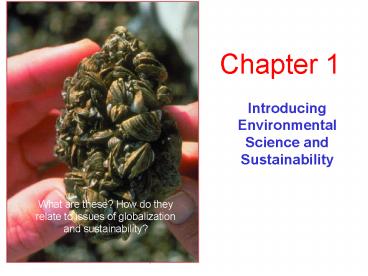Introducing Environmental Science and Sustainability - PowerPoint PPT Presentation
1 / 21
Title:
Introducing Environmental Science and Sustainability
Description:
5) Brazil 195,580,000. Source: US Census Bureau, Global Population Profile: 2002 ... dropped because of an increase in food supplies and better health and sanitation. ... – PowerPoint PPT presentation
Number of Views:27
Avg rating:3.0/5.0
Title: Introducing Environmental Science and Sustainability
1
Introducing Environmental Science and
Sustainability
Chapter 1
What are these? How do they relate to issues of
globalization and sustainability?
2
Human Impacts on the Environment
- Increasing Human Numbers
What does this picture show?
3
Human Impacts on the Environment
- Most populous countries
- 1) China 1,374,853,000
- 2) India 1,155,011,000
- 3) United States 309,163,000
- 4) Indonesia 258,825,000
- 5) Brazil 195,580,000
In what types of countries is most of the growth
occurring? Of the 400 cities with a
population of at least 1 million, 234 are in
developing countries.
Source US Census Bureau, Global Population
Profile 2002
What is a Highly Developed Country? A Moderately
Developed Country? A Less Developed Country?
4
Human Impacts on the Environment
At what type of rate is the population growing?
5
How Fast Is the Human Population Growing?
- At an exponential rate!
- Human death rates have dropped because of an
increase in food supplies and better health and
sanitation. - Doubling Time - A measure of population growth
where the number of years it takes for a
population growing at a specified rate to double
its size. - To calculate Doubling Time, use the Rule of 70.
6
Human Impacts on the Environment
- Poverty
- per capita income of less than 1 a day
- 1.2 billion worldwide currently live at this
level
Inadequate health care Unsanitary water Poor
nutrition Lower life expectancy
7
Relationship Betwen Population Growth, Use of
Natural Resources, and Environmental Degradation
- The resources essential to survival are small,
but individuals in developing countries deplete
these resources because of their increasing
population. - In developed nations, resource demands are large
(extravagent consumers), and resources are
exhausted.
8
What is a Resource?
- Resource -- Anything obtained from the
environment to meet human needs and wants. - Renewable Resource - Can be replenished rapidly
through natural processes as long as it is not
used up faster than it is replaced - Examples?
- What is a resources sustainable yield?
- When does Environmental Degradation occur?
- Nonrenewable Resource - resources that exist in a
fixed quantity or stock in the earths crust - Examples?
9
Population, Resources, and the Environment
- Types of resources
- What does sustainable mean?
- What is the sustainable yield of a resource?
10
Population, Resources, and the Environment
Resource Consumption
- Because of our greater consumption
rates, 1 US child has the environmental impact
of 12 children in less developed countries.
11
Population, Resources, and the Environment
What is the difference between people
overpopulation and consumption overpopulation?
- People Overpopulation when excess of people
cause environmental damage.
- Consumption Overpopulation when people consume
enormous amounts of natural resources.
12
Population, Resources, and the Environment
- Ecological footprint
Ecological Footprint -- the amount of land needed
to produce the resources needed by an average
person in a country.
13
Population, Resources, and the Environment
- IPAT Model
Why is this a good model? Why is this NOT a good
model?
14
Environmental Sustainability
- Sustainability and the Tragedy of the Commons
What is the Tragedy of the Commons?
Garrett Hardin
15
Environmental Science
- The Process of Science
Problem recognition or question
Make predictions
Hypothesis supported?
16
Environmental Science
Controls and Variables in Experimental Design
Variable
- factors influencing processes being examined.
- hypothesis examines ONE variable, holding others
constant. This one variable is called the
independent variable. What this change affects is
the dependent variable.
- Control group
- examined variable is left unaltered
17
Environmental Science
- Inductive and Deductive Reasoning
- Inductive - examines a series of facts for
commonalities that can be concluded. - Example
- Fact an ant has six legs
- Fact a wasp has six legs
- Fact a beetle has six legs
- Conclusion all insects have six legs
- Deductive - examines for relationships among data
moving from generalities to specifics. - Example
- General rule all insects have six legs
- Specific example a grasshopper is an insect
- Therefore a grasshopper has six legs
18
Addressing Environmental Problems
Scientific Assessment
19
Addressing Environmental Problems
- Case in Point Lake Washington
- Scientific assessment
- Public education and involvement
- Political action
20
Addressing Environmental Problems
- Case in Point Lake Washington
Evaluation
21
Addressing Environmental Problems
- Case in Point Lake Washington
Evaluation































